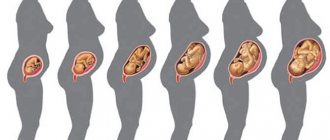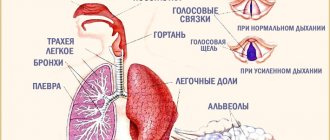The first time a pregnant woman feels the baby kicking in her belly, it can be unexpected—a sudden reminder that the tiny creature growing inside her has a mind of its own. But why do babies kick?
Animation made from MRI scans showing a baby kicking at different stages of development.
Although the uterus is a limited space for movement, it turns out that movement is vital for healthy bones and baby development.
The fetus begins to move in the uterus at about 7 weeks when it slowly flexes its neck, according to a review article published in the journal Ultrasound in Obstetrics & Gynecology. As babies grow, they gradually add more movements to their repertoire, such as hiccups, arm and leg movements, stretching, yawning, and thumb sucking. But mom won't feel much movement - like kicking and hitting - until 16 to 18 weeks into her pregnancy, when baby is a little stronger.
Why does the child move a lot?
The baby pushes hard in the stomach - many women worry about this during pregnancy. But no less than expectant mothers, who, on the contrary, are frightened by the lack of movement in the womb. Both are interested in how a child should move normally? But every pregnant woman’s body is individual, and outside advice is not always applicable to a particular situation.
Usually the first movements are felt between 18 and 22 weeks. Hardly perceptible movements are eventually replaced by active, strong tremors. Why does the baby move unusually in the womb? The intensity of movements is influenced by several factors.
1. Gestational age.
As the term increases, the baby grows, grows stronger and becomes stronger. This is why light tremors turn into very sensitive “kicks” over long periods of time. From 24 to 32 weeks is a period of rapid growth of the child, it is at this time that the movement inside is especially noticeable. The number of movements decreases by the time of birth, but the strength does not stop growing.
2. Nutrition.
If the child is actively moving, then he may not have enough oxygen or nutrition. Relative signs of this can be seen on ultrasound. This is premature maturation of the placenta, for example.
3. External factors.
The baby’s intense reaction occurs to external influences. Examples of external stimuli can be: the voice of dad or mom, loud music, sound in the subway, a car horn, or just someone’s hand on the child’s “house.”
4. Mode.
The baby's wakefulness in the mother's belly does not always occur; he has an individual regime. Sleep takes up most of his time; on average, he sleeps for 3 hours, followed by a short break. The strength of the kicks is influenced by the baby's temperament or mood.
5. Mom's emotions.
An active reaction to the mother’s mood begins around the 25th week of pregnancy. A bad mood often causes active movements of the child, but some children, on the contrary, calm down and wait for the “atmosphere” to change. Staying in one position for a long time, for example, at the computer, can provoke the baby to move, which will sound like a call to change occupation; the so-called request to move is a common reason why a child pushes hard in the mother’s stomach.
Certain moments require vigilance. Starting from week 25, the baby should move about 10 times per hour. But he may not move at all for 3 hours, as this is the normal time for continuous sleep. If the fetus moves regularly, the mother should not worry. The reason to be wary is if the child pushes hard in the stomach for a long time, without breaks. This may portend hypoxia - lack of oxygen. Acute oxygen deficiency can be diagnosed by a doctor by listening to the fetal heart sounds, as well as by prescribing a special ultrasound. The main task in case of hypoxia is to improve the baby’s nutrition. Hospitalization may be required. But don't worry ahead of time. Many mothers are hypervigilant and panic with or without reason. If the fetus is passive, it is recommended to eat something sweet and do exercises. If the baby answered, everything is fine, otherwise you should repeat the same thing after 2-3 hours, perhaps he is just sleeping.
Calmness and a positive attitude are the key to the health of mother and baby in any period of life and development.
Source
How to recognize a baby's first greeting?
From the day when the baby first kicked the mother’s tummy, women perceive the fetus as a child and feel like a future mother to the fullest. That's what psychologists say.
Moms are afraid to miss the first fetal movements during their first pregnancy because they don’t know what they look like. But later they say: “. it can’t be confused with anything else, it’s unforgettable.”
Often pregnant women describe their feelings like this:
- an air bubble rose to the surface;
- the fish perked up;
- a butterfly in closed palms is trying to take off;
- the ball rolled.
In addition to beautiful poetic comparisons, most of all women attribute the similarity of the baby’s first movements to banal flatulence. Since during pregnancy the digestive system “lives by its own rules” and often “delights with surprises,” mothers may miss the first uncertain tremors of the baby, mistaking them for intestinal peristalsis.
You can feel your baby at 13 weeks. When they say that every pregnancy is individual, we are talking about all processes
Doctors draw the attention of mothers to the period 16-22 weeks of pregnancy, when you should listen carefully to the baby
20-22 weeks is the period when the baby’s movements become more orderly and resemble a newborn. In 30 minutes, a five-month-old baby can make 20-60 different movements. And if you consider that the baby has also grown up, then it is impossible to miss the movements or confuse them with something else. At this stage, movements become distinct, and first-time mothers should not be afraid that they will not be able to recognize them.
The child often pushes in the stomach - when it is considered normal
A woman begins to feel fetal movements approximately from the middle of pregnancy. All these movements are naturally associated with many physiological processes occurring in the body of a pregnant woman. A woman may notice that the fetus moves in response to emotional stress or after eating sweet foods, etc. Indirectly, excessive activity of the fetus may indicate existing abnormalities during pregnancy. Physiological reasons for fetal mobility In addition to the above reasons, the child often pushes in the stomach in the following cases:
the woman has taken an uncomfortable position, while the fetus becomes cramped and its movements become more active; environmental stimuli (for example, loud noise) can “wake up” the child, causing him to push more often; The individual wakefulness regime of the fetus and the pregnant woman may not coincide. Therefore, a woman may feel active tremors at night. During the day, the child is “rocked” by the woman’s physical activity. The above situations are typical for pregnancy in the last trimester.
Pathological causes of excessive mobility The most common reason why a child moves frequently is hypoxia (oxygen starvation). There are many prerequisites leading to this condition: abnormalities of the placenta, somatic diseases of the mother (anemia, diabetes, etc.). A specialist can determine whether oxygen starvation exists, as well as the severity of the pathological condition. For this purpose, he listens to the fetal heartbeat, prescribes an ultrasound examination and performs fetal cardiotocography (that is, using a special device, fetal heartbeats are recorded with a graphic display). Using Doppler ultrasound, the intensity of blood flow in the arteries of the placenta is determined.
Source
How and when the baby moves in the stomach, norm and pathology
By the way the baby moves in the stomach, you can determine his well-being. Tremors are a physiological norm, because during the process of embryonic development, the skeletal muscles and nervous system begin to function in the fetus. To maintain normal muscle function, he begins to actively move. In addition to natural needs, movements occur as a reaction to external and internal stimuli.
Gestation period
Most often, movement in the lower abdomen occurs in women of reproductive age. The cause of this phenomenon is pregnancy. Most people are familiar with those feelings when the unborn baby makes itself felt by pushing against the walls of the uterine cavity.
The first time the fetus begins to move is when it is three to five weeks old. This is due to the fact that the hearts of the unborn baby have already begun to beat. Unfortunately, at this moment the pregnant woman still feels nothing, because the size of the fetus is very small.
The first movements appear around 12-20 weeks. It all depends on how the fetus is positioned relative to the uterus, what kind of pregnancy it is and what the physique of the expectant mother is.
Doctors have found that the child’s movements depend on several factors:
- Fetal activity increases in the evening.
- The movements directly depend on the mother’s mood. If a woman is afraid or cries, the baby will behave quietly.
- The child becomes calmer when a woman engages in physical activity. It's better to rest more often.
- After eating, the motor activity of the fetus increases.
- Environmental sounds affect fetal movement. If something scares him or calm music is playing, the baby will be quiet.
- The child begins to move actively if the mother takes an uncomfortable position.
As the child grows, movements become conscious. But if the baby is sleeping, then he stops moving for a while.
First movements
The embryo begins to move at 7-8 weeks, but during this period of intrauterine development it is characterized by its small size. Therefore, his activity goes unnoticed.
The tremors become more noticeable at 16-20 weeks of pregnancy if the woman is hypersensitive or thin.
In 74% of cases, women feel a slight movement of the baby at the 23rd week of embryonic development. In the early stages, movements are rare, they appear 1-2 times in 24-72 hours.
Why is the baby pushing?
In the second trimester of pregnancy, intense fetal movement is observed. The embryo turns over freely or extends its limbs. The tremors and their pace are individual for each fetus. The baby in the tummy takes a more comfortable position, so the woman feels movements inside herself.
How a woman feels at the first sign of a baby moving
What does a woman feel when her baby moves for the first time and how can she recognize this moment? Undoubtedly, all expectant mothers ask these questions. Therefore, let's look at the main signs that indicate the child is moving.
In most cases, when the fetus moves, the woman feels small tremors. However, in the early stages of pregnancy they are not very pronounced. In this case, the expectant mother feels only some movements of the fetus. As a rule, women begin to feel the movement of their baby between 19 and 21 weeks of pregnancy.
It is quite difficult to unambiguously describe the feeling a woman experiences when her baby moves for the first time. Some expectant mothers note that this feeling has many similarities with increased intestinal motility. Other women say that the baby's movement is similar to a butterfly fluttering, objects rolling, or a swimming fish. In any case, such sensations are completely painless for the mother herself and do not cause her discomfort throughout the remainder of her pregnancy.
Only as the child grows more rapidly can a woman feel the baby’s movements, more pronounced than in the first months of pregnancy. The activity of fetal movement is associated with the time of day, the movements of the mother and her physiological rhythms. Having learned to recognize the baby's movements, the mother can even control their activity, regulating their eating patterns, as well as sleep and wakefulness.
For a woman, especially a first-time mother, the first movement of her baby is an extremely touching moment in her life. At this moment, for the first time she can feel a living person inside her, which for many expectant mothers is an incentive to take a more responsible attitude towards their pregnancy.
Due to the individuality of each woman’s body, expectant mothers feel the first movement of their child in completely different ways. The timing during which the first fetal movement occurred may also differ. This depends on the woman's body type and whether the woman is primiparous or multiparous.
The influence of the environment on fetal behavior
The child reflexively reacts to changes in the world around him. Movements are provoked by the following factors:
- touching the belly of the expectant mother;
- light stimuli;
- emotional state of a woman;
- sound;
- smells;
- bright light.
From 24 weeks, tremors can be felt if you put your hand on the belly of a pregnant woman. The embryo reacts to the first touch with calm. If you do not remove your hand, the fetus will adapt to the new sensations and continue to move.
Often the baby pushes the uterus hard in response to a strong noise or unpleasant odor.
This behavior is provoked by irritation - the fetus gives a signal to the mother about danger.
Hormonal imbalances also cause a negative reaction in the child.
Condition of the placenta
The placenta, or also called the baby's place, performs a decisive function in the development of the fetus and its receipt of nutrients. But it can also cause abnormal pregnancy conditions. The mature placenta looks like a cake or an oval. Using an ultrasound, the doctor carefully examines the indications for the development of the placenta, as it grows along with the fetus. If it is very large - it is more than 800 g, then the child either has Rh factor incompatibility with the mother, or the mother has syphilis. If, on the contrary, it is small (less than 400 g), then, most likely, at 28 weeks of pregnancy, the development of the fetus lags behind in its indicators.
The influence of odors
Strong odors can increase fetal activity in the uterus. The most irritating effects are caused by chlorine, acetone and other strong odors of synthetic compounds. When the mother inhales, volatile substances pass through the lungs into the blood, which passes to the embryo. Toxic components provoke an inadequate reaction of the child, who warns the mother about the intoxication of the body. She must get rid of the unpleasant odor in order to protect the body of the unborn baby from the negative effects of toxic compounds. The latter can provoke the development of intrauterine anomalies.
A similar reaction can be observed when a pregnant woman smokes. Salts of heavy metals, when released into the blood, reduce the level of hemoglobin, which is why the child begins to hit the walls of the uterus.
Your baby will start moving before you feel it.
The first movements begin at the 8th week of pregnancy, when impulses begin to be transmitted through the nerves to contract and maintain the tone of the skeletal muscles. The rudiments of muscles and nervous tissue must create movement for the normal functioning of other organs and systems. Activity is necessary for normal blood supply to tissues. With increased physical activity, intracellular metabolic processes intensify, and the rate of tissue differentiation and growth increases.
Under conditions of physical inactivity, normal fetal development is impossible, because in the absence of movement, metabolism is disrupted and circulatory disorders occur. Low mobility causes muscle tissue atrophy and provokes the development of nervous system abnormalities.
When the baby starts pushing
For the first time, you can feel the tremors of the embryo at 17-18 weeks of pregnancy. At the initial stage, it is felt inside the abdomen. A woman may confuse the tremors with abdominal cramps or peristalsis of the digestive tract. Starting from the 5th month of intrauterine development, the fetus moves more actively. Pregnant women feel strong kicks or blows from the unborn child. If a woman notices this feeling ahead of schedule, this is normal. This phenomenon is typical for girls with thin or sensitive uterine endothelium.
Why do mothers feel their babies at different stages?
First-time mothers are simply tormenting themselves with the question: when can you feel the cherished tremors? There are several factors that affect the sensitivity of the mother:
- weight – the mother will feel the pushes of a large child earlier;
- individual sensitivity;
- the constitution of the mother’s body - thin mothers feel movement earlier than those who intensively gain weight;
- intestinal problems;
- volume of amniotic fluid.
Even though the feelings of pregnant women are far from unambiguous, all children begin to move actively and in an orderly manner from 16-18 weeks. Before this, all movements are more like a reflex chaotic muscle contraction.
From the 24th week, the fetus already communicates with the mother through movements
Intrauterine movements indicate normal well-being of the embryo. From 18 to 20 weeks, its activity is low and does not appear every day. It is recommended to record kicks from the beginning of the 6th month of pregnancy, when the fetus can move its limbs or move in the uterine cavity. The child moves chaotically in response to external stimuli or the emotional state of the mother. With the help of tremors, the fetus informs the pregnant woman about its well-being. The frequency of movements may vary depending on the behavior or emotions of the fetus.
If the baby kicks, that's good
If a child kicks in the stomach, this indicates his good health and normal intrauterine development. High activity is observed from 24 to 32 weeks. With the help of pushes, the child communicates his mood or changes in it.
��������� �����: �������� ����� � ����� ��� ������������ – �����
������ ������� ���� � �������������� ���� �������, ����� ��� ������ ������� ��������� ������. ��� � �� �����������: ���� ���������� ������ ������������ ���������� ������� ��� ������������ ���������, � �� ������ �������� �� ������.
�� ����������� ��������� ����� �� ������ ��� ����������� �������, �� � ��� ������� ������������ ���� ������������. ��������, ��������, ��� � ���, ��������� ������� �������, ���� ��������� ������ 20 ������ ����� ���������� ������. � �� �������, ��� ��� ����� �����, ����� ������� ���������� � ��������� ����� 22–23 ������.
�� ����� ����� ���������� ������ ������
� ��� �������� ��������, �� �� ����� ���� ����� �������� ��������� � ������ ������� ������, ��� ��� ����� �������. ������ �������� �� ��������� ���, ��� ������ ��� ����� � ����� ���������� �������������.
����, ������� ���� ������ ������� �������, ���� ����� ������� ������� ������ �� 20–23 ������. � ����� ������� ����� ������ ��� �������� ���������� ����, ���������� �������, � � ���� ������� ���������� «�����������» �� ����.
�������, ��������� ������� ��� �������� �������, ����� ������������� � ������������� � ��� ���������, ������� �� ������� ��������� ������ ������� ������ – � ������ 16 ������.
���� � ���� �������, �� ������� ������� ����� ������� �������� �������������� – �������� ������. � ���� ������ ������ ��������� �� 15–16 ������ � ����� �����������, ������������ ��������. ����������� ������� �������� ��� ������ ���.
���� ��������� ����� ����� �������� �� ���� ������: ��������� ���� ����������� �������� ������ ������, ��� ������� � ����� ������� �������.
����� ��������, ��� �������� ������� ����� ��������� ���� �� 6–7 ������ ������������, ����� ��� �������� ���������� ����� ��������������.
�� ����� ������ ��������� ������ ��-�� ������������� ���� ���� �������. ��� ���������� ������ ������ �������������, ������� ��� ���� ������� � ������.
�� ��������� �� ������ ����� ���������� ����� �������, ��� �� ����� �������� ��������� � ����� � ������ ���, ��� ��� ��������.
������ ���������� – ����� ������� ��� ����. ���� ������ ������ �������������� � ���������, �� �� ���� ����� ��� ����� ������� ������ ������ � ��� �������.
��� ������ �� ���������� �������?
�������� ���������� ������� ������ ����������� ��������
�������� �������, «����������» � ���� ������ ��������������.
�� ������������� �������� ������ � ��� ����� � ����������� ������. � ����� ���������� ������������ ���, ����������� ��������� �������, ����������� ����� � ������ ������.
�� � ���� ���� �� ������ ����� �������������� �� ���������� ������. ��������, �������, ������� �� ����� ������������ ����� ��������� �����, ���������� �����������, ������ ����������� ��������. ������� ���������� ����������� ��������, � �� �������������.
� ��� ����� ���� ����������, �����, ��������, �������� ��������� � ����� ������������� � ����� ����������� ���������. ������� ����� ���� ������� � ����������������� ������ ������������: ����� �� ���� ������������.
������� �������� ��������� � �����, �� ��������� �� ���������� � ����������� �� ����.
��������� ��������� �� ����� ������������ ����������� � ��� ����� � �� ��������� �����. ��� ������ ����������� �� �����������, ��� �������� ������. ��� ������-�� ��� ����� �������� �������� � ����������� � ���� ������ – ��� ��� ������������ �� ����� �����.
����� ����, �� ���������� ���������� ����������� ������������ ����� ���� ���������, � ��� ����� � ��������. ������� �� ��� � ���������� ������� ����� � ��������, � ���������� ������� ������� ��� �������� �������� ���� �� ������ �������, ���������� – �� ���� ���� ����.
������ ���������� ������� �� ���������� �������?
����� ����������� ����� ��������� � �������� ��� ��� ���������, ��������� � ����������� �����. ��������� ��, ����� �������� ���������� � ��� ���������, �������� � ���, � ����� �� ��������� ���������.
���� ������ ��������� � ������� ����� ������, �� ����� �������� ����, ���� � ������ – � ������ ��������� �����������.
�������, ��������� ������� – ������� ����� ��������������, � ���-���� ����� ���� ���� ����� � ����������. �� ����� ����������, ���� ����� �� ���� � ���� ����� � ������� ���������� ����� – �� ����� �������� �����.
�� ���� ������������� ������������, ��� ����� �������������. ����� ���������� ����������� ������ ��� ������ ���������� ����������, ������������ ��������.
���� � ��� �� ��������, ��� ���������� ����������� ������������ ����������.
��������� ��������� � ����� ������ ���� �����������, � ����, ��� �������, ����� �� ������ ��� ��������� « �� ���� ����������».
���� ��������� – �����
���� ��������� – �����, ��� �� ����� ��������� ������� �� – ��� ����� ��� ��������� � �����.
����� ��������� ����� ���� ������� � ���������� �������������, ������� ���������� ������ ���������������. ����� ��������� ���������� � ���, ����� ������� �������.
���� ����� �� �������� ��������, �������, � ���� �������, �������� ��������� ���������� � ������� ��� � ������, ��� � � �����.
����� ��� ��������-���������� �����������, ������, ������, ������������ ��������� ����� � ����� � ������. ��� ����������� ��������� ���������� ���������� ���� ����� ��������� �������� �������.
���� ������� �����������, ������������ ������ ��������� ��� ����������� ����������� �����������.
���� ��������� – �����������
�� �� ����� �������� � ������� ����������� �������� �����, ������� ���������� ���� ���� � ����������. ���������� ����������� �� ���� ������� �� ������: �� ����� ���������� ��������� � ��������� ����.
���������� ���������� �������� ��� ������� �� ������� ������ – ���������. ����� ���������� ��������� ������ ������, ��������� ���.
�� ���� ��������� ������, �� ������� � ��������� ������� ����, � ����� ����� ���������� �����������.
�������, ��� ����������� ������� ��� ����� �������� ��� ����������, ������ ��� �� ����� ��������, ��� ����� ���� ��������� � ��� ����-�� �� �������.
��, ���������� ���������, �� �� ����� ������� ������ ���������� ����� ������� �������� �������. �������� ������ �������� ��� ������������. ����� ����������� ��� «���������» � ����� ������� ������������ � �������� � ������������. ���������, ��� ��������� ����� ������ ����� ��� � ���, � ��� �������������� ��������� ������ �������� ��������� �� ���� ������ ����� �������.
Source: https://mama.neolove.ru/pregnancy/different/shevelenija_ploda_varianty_normy_i_povod_dlja_bespokojstva.html
How to properly check movements at home. 2 special tests
In the third trimester of pregnancy, a woman should keep a calendar of fetal movements. In it, the expectant mother records the number of kicks over a period of time. To assess the activity of the embryo, there are 2 tests:
- Count to 10. In this case, on a special form you need to mark the number of embryo movements every day. A woman should count her kicks for 12 hours. If the number of movements during this period is less than 10, she needs to see a doctor.
- Sadowski's method. After the evening meal, the pregnant woman should lie on her left side and count the movements of the embryo. Normally, he should push the uterus about 10 times in 60 minutes. If the number of movements is less than normal, counting continues for the next hour. In the evening, due to an increase in serum glucose levels, fetal activity increases 3-4 times, so during this period pathologies can be diagnosed in time.
Fetal movements may be slightly painful
If the baby moves a lot in the stomach, the expectant mother may feel pain. In such a situation, the pregnant woman is recommended to change her body position. If the pain does not go away for a long time and the child remains active, you should immediately consult a doctor. The symptom may indicate oligohydramnios or hypoxia.
In the third trimester, mothers feel pain in the hypochondrium, which is within the physiological norm. The uterus rises high during pregnancy, so the baby reaches this area and can strongly push the placenta in this area.
Parasites
What else could be moving in the stomach besides pregnancy? The most common cause is helminths. It is a mistake to believe that parasitic worms can settle in the body only of those who ignore the rules of personal hygiene.
The army of parasites is too diverse and they penetrate not only with food. It is not difficult to determine the presence of helminths, but most often the symptoms are attributed to other pathologies. Modern diagnostic measures and tests can accurately determine not only the type of parasite, but also its location within the body.
Most often, helminths live in the intestines, and manifestations can be varied and affect all organ systems. Symptoms of parasite infestation include:
- Stool disorder.
- Headaches that are provoked by intoxication with waste products of helminths.
- If roundworms, dysenteric amoeba, and lamblia clog the ducts coming from the gallbladder, then jaundice of the skin develops.
- The development of anemia due to the formation of ulcers and erosions on the intestinal mucosa, which constantly bleed.
- Dysentery.
- Development of appendicitis.
- Intestinal obstruction.
- Enlargement of the liver.
Most often, to quickly and effectively get rid of parasites, they resort to taking anthelmintic medications. There is currently no shortage of such funds. Before prescribing the medicine, the doctor will send the patient for tests to determine the type of parasite.
Popular medications include:
- Albendazole. It is a broad-spectrum drug that will help get rid of Giardia and other helminths.
- Pirantel. It copes well with pinworms, roundworms, nematodes, and whipworms.
- Decaris.
- Vermox. Will help cope with enterobiasis and other helminthic infestations.
- Metronidazole. Prescribed to patients who are infected with parasitic protozoa.
For the drug to work effectively, you must follow a special diet recommended by your doctor. The diet should improve the flow of bile and the process of cleansing the intestines. After a course of drug therapy, it is necessary to ensure that dead parasites are removed so that they do not decompose inside and are not poisoned by toxic products.
Smart kid. Why are fetal movements too active?
If the child moves very much, you need to calm down. An inadequate reaction of the embryo is observed when there is a sharp change in the psycho-emotional state of a woman. In addition, from the 20th week, when the cartilage tissue of the hearing aid begins to harden, this reaction is typical in response to loud sounds.
What to do if your baby pushes a lot
If your child is pushing in his stomach, you should talk to him. It is easier to detect fetal movements in a calm environment. When the mother's body is in motion, the activity of the embryo decreases. This is caused by fluctuations in the amniotic fluid, which calms the unborn baby. Therefore, if there are strong and painful tremors, it is recommended to go for a walk or turn on soft music in the room.
What baby activity should cause concern?
The child can move very actively. If intense movements suddenly stop, it is necessary to immediately exclude the possibility of embryo hypoxia. Oxygen starvation can lead to fetal death.
If the unborn child feels that the concentration of hemoglobin in the blood entering him decreases and oxygen stops flowing, he begins to push hard for a long time. Mothers need to pay attention to this. If the situation is not corrected, the child may lose consciousness or die. As a result, the tremors stop abruptly.
At what rate of baby's movements should you contact a doctor?
At the end of the 6th month of embryonic development, the intensity of fetal movements may decrease for a long period. From 26 to 28 weeks of pregnancy, the expectant mother can feel up to 10 kicks in 3 hours. In some cases, a fetal activity calendar should be kept, which will help record fetal movements. This is necessary in order to diagnose the pathological process in time and seek medical help. Women with Rh-conflict, people with chronic diseases and injuries are at risk.
If an active child has stopped moving for a long period, it is necessary to walk or eat a confectionery product.
If there is no reaction, it is recommended to consult your doctor. If the movements cause pain, the child may be in an awkward position and cannot change his position. In this case, in order to reduce the risk of developing oxygen starvation of the fetus, it is necessary to change the position so that the vessels are not compressed.
Active movement helps the fetus develop bones and joints
Even in the early stages, the fetus begins to move its arms and legs in order to start the process of formation of joint tissues and bones. Active movement helps improve intermolecular influence in the baby's skeletal system. In other words, the fetus, even in the process of ripening, trains its musculoskeletal system. The baby performs a similar “procedure” with the lungs. From about the middle of the second trimester, the baby begins to swallow amniotic fluid, thereby developing the respiratory system.
Irish scientists also noted that babies who were not very mobile in the womb are born with weaker bones than babies who were actively moving in their mother's belly. If the fetus moves little in the womb, then in the future this can lead to underdevelopment of joint and bone tissue.
It is important to understand that the baby’s activity in the womb is an individual concept. Some babies can do 20-35 movements daily, others - only 10-15. Both are considered the absolute norm. You should only be concerned in certain cases.
So, if a child used to actively kick in the stomach, but then almost stopped moving, you should immediately consult a doctor. Lack of fetal movement may be a symptom of late pregnancy. If the baby kicks too often and actively, you should also contact a specialist and conduct an ultrasound. Perhaps the baby suffers from an excess of glucose in the blood (due to the fact that mom often eats sweets!).
Expectant mothers should closely monitor fetal movements starting from the 28th week of pregnancy. Normally, the baby should make from 10 to 35 tangible movements per day. If you deviate from the norm, you should definitely check with a doctor.
Source
How is oxygen starvation of the fetus expressed?
Increased activity of the embryo for a long time indicates its oxygen starvation. However, strong tremors are not the only symptom. Increased frequency and intensification of movements is observed only at the initial stage of hypoxia. If the serum hemoglobin level does not rise for an extended period, the frequency and activity of movements weaken and stop. Therefore, a pregnant woman should immediately seek help from a doctor if she feels less than 10 kicks per day or weak movements of the embryo after 30 weeks.
Increased fetal activity after prolonged sleep warns of hypoxia. To accurately determine the condition of the embryo, cardiotocography and ultrasound are performed, the speed of blood flow in the fetal aorta and its cerebral circulation are measured.
How to find out that hypoxia has begun
In stationary conditions, the following instrumental methods allow you to monitor the movements and condition of the fetus:
- Ultrasound screening;
- auscultation of the fetal heartbeat using an obstetric stethoscope;
- cardiotocography (CTG);
- Doppler and blood flow velocity measurements using electrodes.
Women with bad habits or Rh conflict with the fetus are at risk. A pregnant woman should seek advice from an obstetrician-gynecologist if she does not notice embryo movements within 24-48 hours. After taking a history, the doctor listens to the fetal heartbeat using a stethoscope. Normally, the child should react to the touch of a cold device with a push, but under conditions of hypoxia no movement is observed.
If the fetal heartbeat is normal, the doctor will recommend that the mother walk more in the fresh air and not sit for a long time in an uncomfortable position.
To prevent oxygen starvation, a pregnant woman should balance her diet and breathe deeply.
If there are pathological noises or a low pulse rate, the gynecologist prescribes an ultrasound. An ultrasound examination will allow you to find out the exact size of the fetus, assess the formation of internal organs and systems, and detect movements. During the procedure, the doctor determines the amount of amniotic fluid and the condition of the placenta in order to exclude detachment of the placenta and oligohydramnios. If hypoxia is suspected, the doctor focuses on the thickness of the placenta, the position of the umbilical cord and the size of the fetus.
How does a baby move just before birth?
Before labor, from 32 to 36 weeks, the following changes are observed:
- the child reduces activity;
- the kicking stops, the embryo prepares for birth, contractions begin;
- During uterine contractions, the fetus actively moves, but these sensations are overshadowed by severe pain.
To track the dynamics of movements and evaluate the heart rate of the embryo, doctors connect a CTG machine.
Norms and control over the child’s movements
A woman may not feel fetal movements for up to 3-4 hours, which normally means the fetus is asleep. If this period has passed, the pregnant woman can stimulate the activity of the embryo. To do this, you need to direct cold water to your stomach or hold your breath. In the latter case, the level of hemoglobin in the blood will drop and the child will begin to move, becoming concerned about the sudden changes.
To determine whether the embryo is moving within normal limits, the timing of the tremors should be recorded and each movement should be monitored. It is necessary to record the time of every 10th fetal movement, which should occur over the last 2-3 hours.
When should you consult a doctor?
The reasons why a pregnant woman's stomach is shaking may be:
- ectopic pregnancy;
- flatulence;
- abdominal aortic aneurysm (pathology of the vessel wall, characterized by its expansion and stretching);
- hypertonicity of the uterus.
Self-medication while carrying a child is dangerous, since two lives are at risk: the expectant mother and the child. The appearance of signs of pathology should be discussed with your doctor, who will prescribe the necessary examinations and tests, and also prescribe treatment, if necessary.
Why may a child move little or stop doing so?
If a pregnant woman feels less than 10 kicks per day, or the baby does not move for about 3-4 hours, you should consult a doctor. In most cases, a sharp decrease in activity indicates the development of fetal hypoxia, in which embryonic movements may be absent for 12 hours. If the pathology is not detected in time, the fetus freezes.
Physiological reasons
A child may reduce activity for the following reasons:
- the woman is in a noisy room, loud sounds can frighten the embryo;
- the fetus is in a state of sleep;
- a pregnant woman goes in for sports - with active movements, vibrations of the amniotic fluid are created, and the child may fall asleep;
- childbirth is approaching.
2-3 weeks before birth, the embryo reduces physical activity. At the same time, there are movements.
Starting from week 28, the fetus increases in size, occupying free space inside the placenta. It becomes difficult for him to move and roll over. The cramped space limits his activity.
Symptoms
The alarming clinical picture begins with the appearance of sharp and severe pain in the lower abdomen after 12-24 hours from the moment the fetus freezes. The pain syndrome is caused by increased peristalsis of the uterus, which seeks to get rid of the dead embryo. Other symptoms include:
- increased body temperature above +39°C;
- weakness;
- pale skin;
- increased sweating;
- uterine bleeding;
- thready pulse and drop in blood pressure;
- at a later stage, the breasts return to their natural size.
If your general health worsens, you should consult your doctor for a diagnosis.
Diagnostics
Cardiotocography and ultrasound with Doppler measurements allow hypoxia to be diagnosed in a timely manner. CTG helps to count the number of heartbeats of the embryo and record them in the form of a graph. Cardiotocography additionally determines the tone of the uterus. The procedure lasts about 20-40 minutes, during which the woman presses a button when she feels the embryo kicking.
To clarify the diagnosis, the doctor performs Doppler sonography, with which he establishes the speed of blood flow in the arterial vessels of the uterus and umbilical cord. Ultrasound allows you to evaluate the movements of the embryo, the volume of amniotic fluid, and the muscle tone of the uterus. If the data obtained indicates a serious condition of the child, the doctor decides to initiate premature labor or hospitalize the woman.
Causes for concern
The first cause for alarm is the absence of tremors for 2-3 hours. If movement does not resume after 6 hours, you must call an ambulance. The baby should move at least 10 times in 3 hours before the 26th week of pregnancy. At later stages, up to 12 shocks per day can be considered normal activity. If the movements do not correspond to the norm, it is necessary to undergo an instrumental examination.
Why count the number of movements of the baby in the uterus?
Counting fetal movements has not lost its importance even with the advent of instrumental methods for monitoring the baby. Based on the number of movements of the hearth, its condition is currently assessed
Just as a newborn child cannot let his mother know that he wants to eat, drink or needs to change his diaper otherwise than by crying, so the fetus, while still in the womb, gives “signs” to the mother through movements.
Thus, fetal movement is one of the signs that is used to assess the degree of comfort of the baby in the womb. This indicator is very closely related to the baby's heart rate, and together they make up the fetal biophysical profile (FBP). BPP reflects the supply of the necessary or insufficient amount of oxygen through the umbilical cord to the fetus. If oxygen is supplied in sufficient quantities, the condition is called the normoxic state of the fetus. If movements become too active or, conversely, too rare, the fetus is in a hypoxic state (oxygen starvation).
The main idea of the BPP is to make sure that when the fetus moves independently, its heart rate also increases. This is called the fetal myocardial reflex (fetus - fetus, myocardium - heart muscle). This reflex is very important, since the degree of its preservation can be used to judge the level of development of the centers for regulating body functions, which are located in the brain (respiratory center, cardiovascular center, muscle tone center), or more precisely, their sensitivity to the level of oxygen in the blood.
The frequency of fetal movements depends on the following indicators:
- vascular tone - an increase or decrease in vascular tone (pressure in the arteries and veins);
- levels of chemicals in the blood - such as hormones, glucose, oxygen and carbon dioxide levels;
- blood flow in the uterus and placenta - depends on the condition of the placenta, blood coagulation system and other factors;
- The acid-base balance of the blood in the fetus depends on the state of its metabolism and the normal development of organs.
When the above indicators change, the fetal myocardial reflex is disrupted - the baby’s movements may increase, but there is no heartbeat. Doctors also consider a dangerous condition when a child moves less than expected (this is much more dangerous than when he moves more actively). This means that the brain has stopped responding, and the fetal adaptation mechanisms are disrupted. Violation of adaptation mechanisms occurs in a number of rather severe conditions that require more careful monitoring of the condition of the expectant mother and fetus.
Decreased fetal motor activity is considered a risk factor for the following adverse outcomes:
- congenital malformations of the fetus;
- premature birth;
- fetal head injury;
- developmental disorder of the fetal nervous system;
- low birth weight;
- termination of pregnancy and stillbirth;
- weakness of labor, which forces the doctor to induce labor or perform a caesarean section.
Thus, by counting the movements of the fetus, monitoring the increase or decrease in the number of its movements, dangerous conditions can be identified in time.








